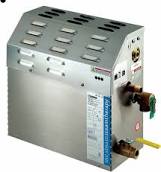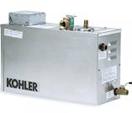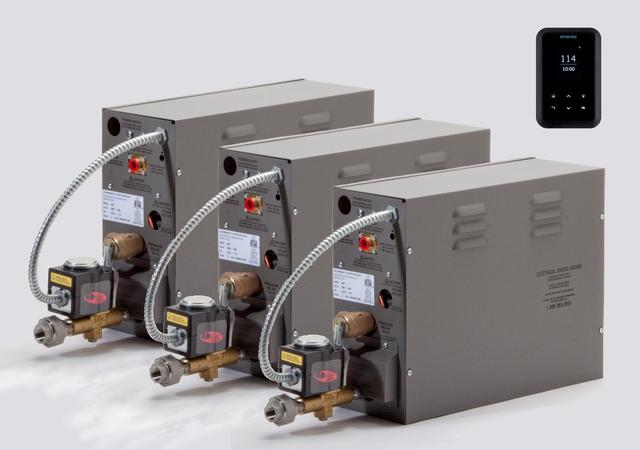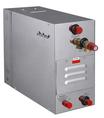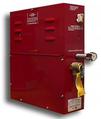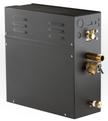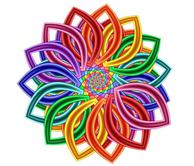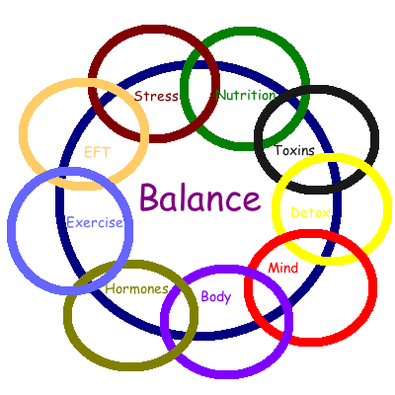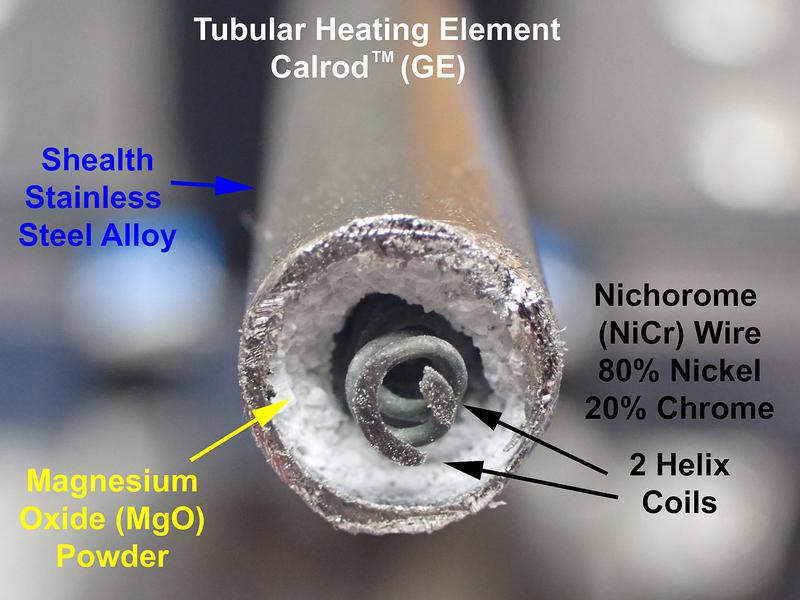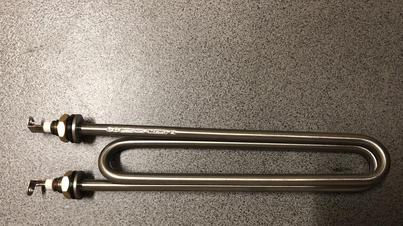Heat Types:
Each steam generator brand can have a different heat type than you might expect if comparing to the one you have been using in the gym or spa. Most people have only experienced commercial steam rooms and when they but a residential one the steam is nothing like those other ones. Depending on the dryness or wetness of the steam generator, the room will be heated up differently. The steam generators that put out more steam at the same temperature will have a wetter steam and wont transfer the heat to the room like the high fluence lower output models.
Note: when the steam droplets from on the walls and ceiling, its is just heating up the walls and the heat is drawn out of the steam room. My goal is to lower the latent heat index and raise the heat coefficient.
Higher wattage and higher output steamers might put out more steam but if the vapor size is too big it will effect how hot the steam rooms gets. The dryer the heat for some can feel more like a sauna. Many people like to breath in steam to help with colds while other people want to sweat out toxins or burn calories.
If trying to detox, the longer I am in the steam room getting a slower sweat where I am not just sweating like a pig and getting my heartbeat up. This depends if trying to burn calories or sweating toxins from the oil glands. (Sebaceous sweat). Remember, fat soluble toxins are not the same as water soluble toxins that many people think they are sweating out when in the steam room (or a sauna).
Heater types
High vs Low Density Heaters - separates the cheap from the good
This is another thing that companies don’t take the time to explain to people buying a steam generator. High density heaters are the heaters everyone wants to avoid in their generator.
High-density and low-density heaters refers to the amount of wattage the heater uses compared to the total surface area of the element. The really cheap generators with high density use a super high temperature to operate.
Some steam generators have 11 foot heaters while the standard is 2.5 feet. The more surface area the less limestone buildup on the heating elements. Also, bigger heaters will last longer. The larger heaters don’t heat the water faster but touch more water at the same time as with nearly 3 times the surface area touching the water makes for a dryer steam. I only recommend the 11 foot heaters for those that are not using a water softener who have hard water.
Note: If getting a steam generator with 11 foot surgical steel heaters, the only way to damage them is if it wasn’t installed correctly and the water pressure reducer was not there.
When to get better heating elements
For those that have hard water or not using a water filter I urge people to only use 304 grade surgical steel heating elements. I get so many pictures of heating elements that are ruined from limescale. Surgical steel heaters are the mostv resistant to limescale. I have never heard of a surgical steel heating element break from limescale. The really cheap heating elements usually found on on the budget steam generators can use cast aluminum heating elements or standard metal (standard stove element). The middle quality brands usually use stainless steel elements. For that never want to worry about replacing their heating elements in their steam generator should make sure the generator has 304 grade surgical steel heating elements. 304 grade is the hardest steel and least prone to limescale corrosion. Having a high corrosion resistant 304 surgical steel heating element as well as a 304 surgical steel boiling tank is the best for maintenance free use.
Below are pictures of different heating elements.
Which steam generator best serves You? I compile useful information to help you make a decision.
Steam Spa - Steamist - MR. STEAM - KOHLER - Amerec - STEAMBATH - THERMASOL -Whirlpool - ROMA - STEAMCORE
Take the
Dry Steam VS WET Steam Generators
The Most important page on this site
How to choose between the 2 Types
Don't buy without reading this page.
1-877-310-8385
Open from 8am till 10pm
Ask for Alex
SteamReviewed.com
Need advice, call Sharon or Alex at 1-877-310-8385
1-877-310-8385
Open from 8am till 10pm
Ask for Sharon
To avoid limescale and heater corrosion, I urge people to use surgical steel heating elements and if that's not affordable then stainless steel (not zinc coated or galvanized).
Surgical steel heating element should last at 30 years and you don't need to add a chemical in the tank to clean them every 90 sessions.
This picture shows what is inside the heating element in most steam generators. I urge people to get the surgical steel (304 grade) heating elements if the water is hard and has a high TDS.
This is a surgical steel heating element. The non-shiny one is a use one that has been used. Notice how there is no limescale crusted on the surgical steel element. These are 304 grade surgical steel. They are much more expensive but you don't have the maintenance work like you would on other types of heaters.
I urge those who are not going to use a water filter and water softener to only use a steam generator that has surgical steel. The 2nd best are regular stainless steel. They will last longer than the galvanized steel and I strongly recommend an auto flush as well as the filter and softener. The manufacturers usually will not honor the warranty if you don't do these things. You will almost always have to replace the elements at your expense. I have never heard of a 304 surgical steel element corroding so if you aren't going to use any of these 3 things to protect your generator, surgical steel heating elements as well as a surgical steel tank is what I urge people to research.
Those that don't want to get their heart rate up to 150 bmp too quick may want a dryer steam that doesn't heat them up to quick. It is very hard to heat my core temperature 3 degrees and maintain it if the steam is too wet and it makes my blood pressure go up too fast to the point I need to get out of the steam room. Let me know if you want a shorter or longer session in your steam room on my quiz.
